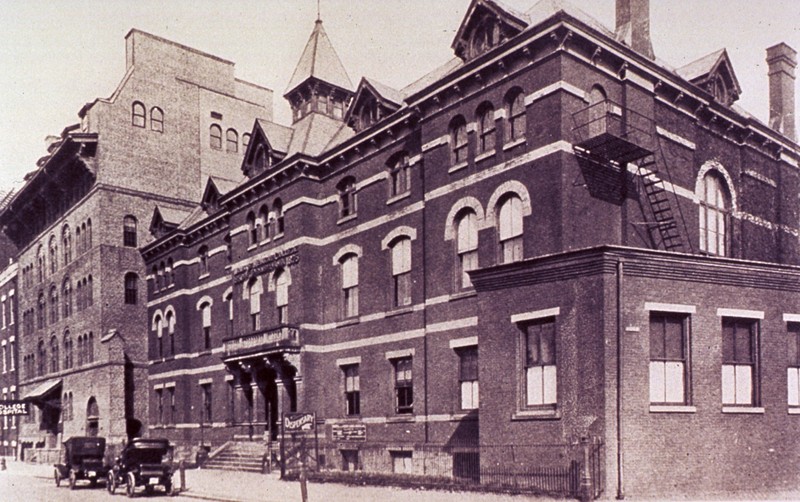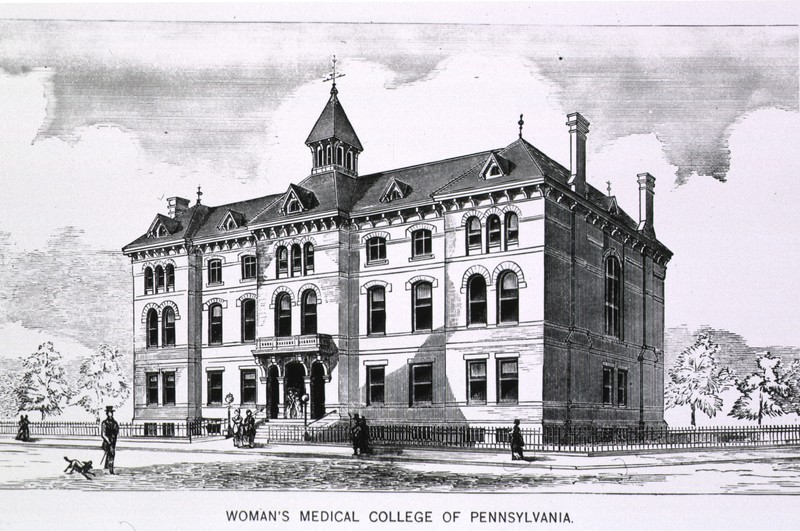Woman's Medical College of Pennsylvania (Fairmount, 1862-1930)
Introduction
Text-to-speech Audio
The Woman’s Medical College of Pennsylvania (WMCP), originally the Female Medical College of Pennsylvania, was one of the first medical schools designed for the professional education of women. Established in 1850 at 627 Arch Street in Philadelphia, it moved to North College Avenue and 21st Street in Philadelphia's Fairmount neighborhood in 1862. While in Fairmount, WMCP grew to become a successful school with an international audience. The college relocated to East Falls in 1930 and exists today as Drexel University College of Medicine.
Images
Exterior view of the Woman’s Medical College at Fairmount, 1914 (from the National Library of Medicine Digital Collections).

Engraving of the Woman's Medical College at Fairmount, 1875 (from the National Library of Medicine Digital Collections).

Backstory and Context
Text-to-speech Audio
The Woman’s Medical College of Pennsylvania (WMCP) was a medical school established in 1850 to train women to become doctors and medical professionals. It was founded originally as the Female Medical College of Pennsylvania and operated at 627 Arch Street until 1862 when it moved to North College Avenue and 21st Street in Fairmount, just north of Girard College and adjacent to the Woman’s Hospital of Philadelphia.
Established during the 19th-century women’s rights movement, WMCP was the second medical training facility for women organized in the United States after the Boston Female Medical College (1848) and the first of its kind in the world to award medical degrees to women. The school was founded by Philadelphian reformers, Quakers, and businessmen just two years after the first woman’s rights convention met at Seneca Falls, New York, where activists argued for many reform ideas, including the woman’s right to education.
Formal medical training for women, though limited in availability and often opposed by established medical schools, was a goal for women’s rights activists for decades. The WMCP fulfilled this desire and trained women to become doctors, surgeons, and physicians in a number of specific medical fields, including gynecology and obstetrics. However, women often faced challenges when attempting to find positions in hospitals. In reality, their medical career pursuits typically developed into private practices, establishing new clinics or hospitals, or missionary work in international areas where women’s health could have been improved. Additionally, during World War I, many of these women worked as military nurses and anesthetists.
The relocation to the Fairmount neighborhood allowed for the college’s facilities to expand and allowed it to form a close partnership with the neighboring Woman’s Hospital of Philadelphia. The Woman’s Hospital was founded in 1861 by Dr. Ann Preston, herself a Quaker and member of the college’s first graduating class. In 1866, Preston became the college’s first woman dean and organized a close partnership between the Woman’s Hospital and college to allow students to train in a functioning hospital. In 1867 under Preston’s leadership, the Female Medical College was renamed the Woman’s Medical College of Pennsylvania.
Despite its early successes, the WMCP was barred from the Pennsylvania State Medical Society, which referred to its prohibition of “medical society members from consulting with women physicians” (Fee) and generally refuted the advancement of women in medical fields. As a result, a group of the college’s graduates formed the Alumnae Association of the Woman’s Medical College of Pennsylvania in 1875, one of the earliest medical societies for women.
In its more than sixty years at the North College Avenue address, the Woman’s Medical College became a fixture in the Philadelphia medical community and in the advancement of equal rights in education and the medical profession. Going beyond women’s rights, the college built a legacy of racial and ethnic inclusionary practices before the end of the 19th century. By 1900, Native American and African American women had earned degrees from WMCP. Philadelphia had become one of the United States' main entry points for immigrants, which was reflected in the international makeup of the WMCP’s student body. Women “from Japan, India, Syria, Jamaica, Brazil, England, Sweden, Denmark, Switzerland, Russia, China, Burma, Australia and the Congo Free State” earned medical degrees from the college (Murray), and Jewish students were also trained at WMCP “earlier than many other medical schools” (Mandell).
The Woman’s Medical College moved north from Fairmount to the East Falls neighborhood in 1930. In 1970, after more than a century as a women-only facility, the school became co-educational and was appropriately renamed the Medical College of Pennsylvania. The college was merged with Hahnemann University Medical School in 1995 and, in 2002, was acquired by Drexel University. The merged institutions were reestablished as the Drexel University College of Medicine, which continues to operate out of East Falls.
Cite This Entry
Michael Griffith on behalf of Girard College. "Woman's Medical College of Pennsylvania (Fairmount, 1862-1930)." Clio: Your Guide to History. April 20, 2022. Accessed March 29, 2025. https://theclio.com/entry/148733
Sources
Fee, Elizabeth and Theodore M. Brown. “An Eventful Epoch in the History of Your Lives.” American Journal of Public Health, vol. 94, no. 3, March 2004, p. 367. Doi: 10.2105/ajph.94.3.367.
Mandell, Melissa M. “Woman’s Medical College of Pennsylvania.” Encyclopedia of Greater Philadelphia. 2016. Accessed April 14, 2022. https://philadelphiaencyclopedia.org/essays/womans-medical-college-of-pennsylvania/.
Murray, Joanne. “Perspective From A Progressive Past.” Pulse, News from the Drexel University College of Medicine. Winter 2016. Accessed April 14, 2022. https://drexel.edu/medicine/news-events/publications/pulse/winter-2016/perspective-from-a-progressive-past/.
“Our Diverse History.” Drexel University College of Medicine. N.d. Accessed April 14, 2022. https://drexel.edu/medicine/about/diversity/our-diverse-history/.
Woman's Medical College of Pennsylvania. Philadelphia. 1914. Photograph. Retrieved from the National Library of Medicine Digital Collections. https://catalog.nlm.nih.gov/permalink/01NLM_INST/1o1phhn/alma9914489083406676.
Women's Medical College of Pennsylvania, Philadelphia, Pa. Philadelphia. 1875. Engraving. Retrieved from the National Library of Medicine Digital Collections. https://collections.nlm.nih.gov/catalog/nlm:nlmuid-101436211-img

